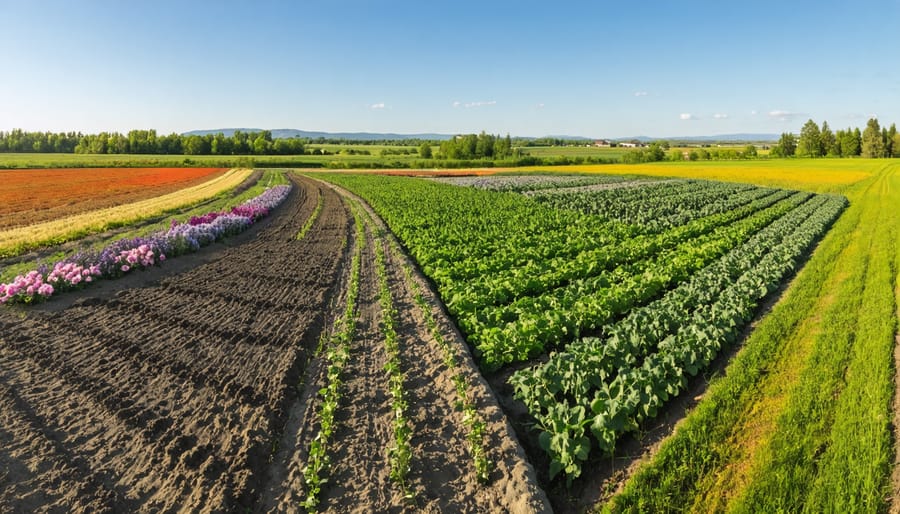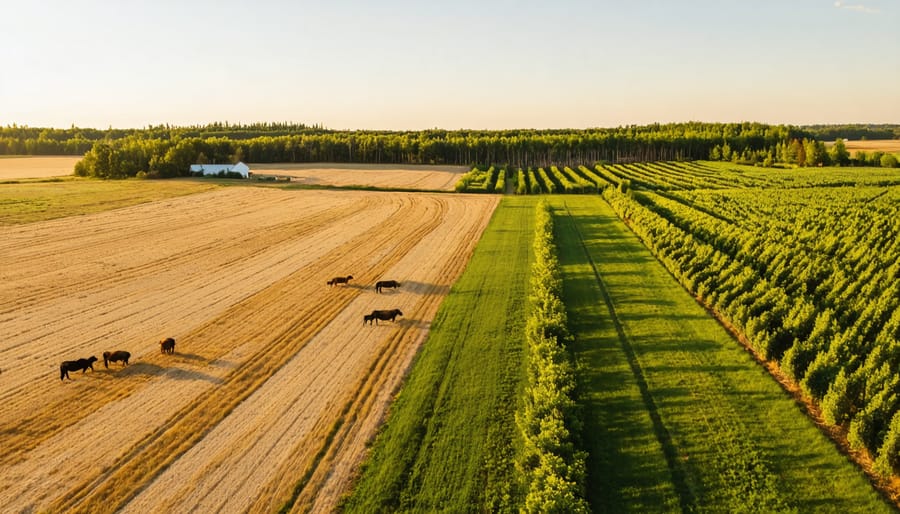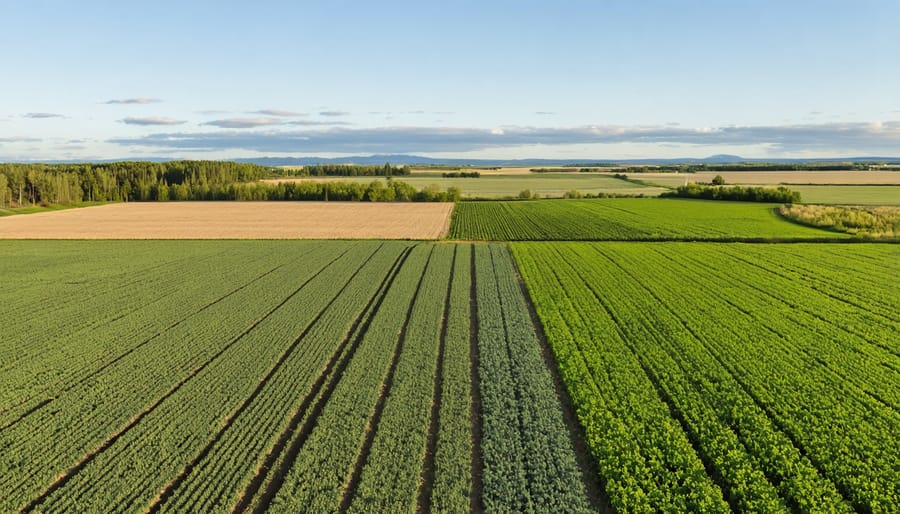Transform conventional farmland into thriving agroecological systems by integrating diverse crop rotations, establishing permanent soil cover, and maintaining living root systems year-round. This proven approach is consistently boosting farm profits through regenerative practices across Alberta’s varied climate zones.
Prairie farmers who implement agroecological methods report 30% reduced input costs within the first three seasons, while building resilient operations that withstand extreme weather events. By combining traditional Indigenous land management wisdom with modern soil science, Canadian producers are regenerating degraded soils while maintaining competitive yields.
The transition to agroecological farming isn’t just environmentally sound—it’s economically vital for the future of Canadian agriculture. As input costs rise and weather patterns become less predictable, farms using integrated pest management, cover cropping, and strategic grazing are proving more profitable than conventional operations. These methods align perfectly with federal agricultural incentives while building long-term soil health and farm viability.
The Core Principles of Agroecological Farming in Alberta
Soil Health Management
Healthy soil forms the foundation of successful sustainable agroecology practices, and Alberta farmers are increasingly recognizing its vital importance. A thriving soil ecosystem contains billions of beneficial microorganisms, including bacteria, fungi, and earthworms, all working together to support plant health and nutrient cycling.
The key to maintaining soil health lies in building organic matter content, which typically ranges from 2-5% in productive Alberta farmland. Regular additions of compost, cover crops, and crop residues help increase this percentage while improving soil structure and water retention. Many local farmers have found success with minimal tillage methods, which protect soil biology and reduce erosion risks common in our prairie conditions.
Crop rotation plays a crucial role in soil management, with legumes like field peas and alfalfa naturally fixing nitrogen and breaking pest cycles. Testing soil regularly, ideally every 2-3 years, helps monitor progress and adjust management strategies. Remember, healthy soil not only produces better yields but also helps capture carbon and build resilience against extreme weather events, which is increasingly important for our farming future.

Biodiversity Integration
Alberta’s farming landscape thrives on biodiversity, where carefully planned crop diversity works hand-in-hand with beneficial insects to create resilient agricultural systems. Successful farmers in the region typically rotate between 4-6 different crops, including cereals, pulses, and oilseeds, which helps break pest cycles and enriches soil health naturally.
Native pollinators and beneficial insects play a crucial role in Alberta’s agroecological systems. Species like hover flies and ladybugs serve as natural pest control, while native bees complement honeybee populations in crop pollination. Farmers are increasingly establishing beetle banks and flowering field margins to support these helpful insects throughout the growing season.
Creating habitat corridors between fields has shown promising results in southern Alberta farms, where studies indicate up to 60% reduction in pest-related crop damage when natural biodiversity is properly integrated. Local farmers report that maintaining uncultivated areas with native prairie plants not only supports beneficial insects but also provides shelter for birds that help control grasshopper populations.
By embracing these biodiversity principles, Alberta farmers are building more resilient farming systems while reducing their reliance on chemical inputs.
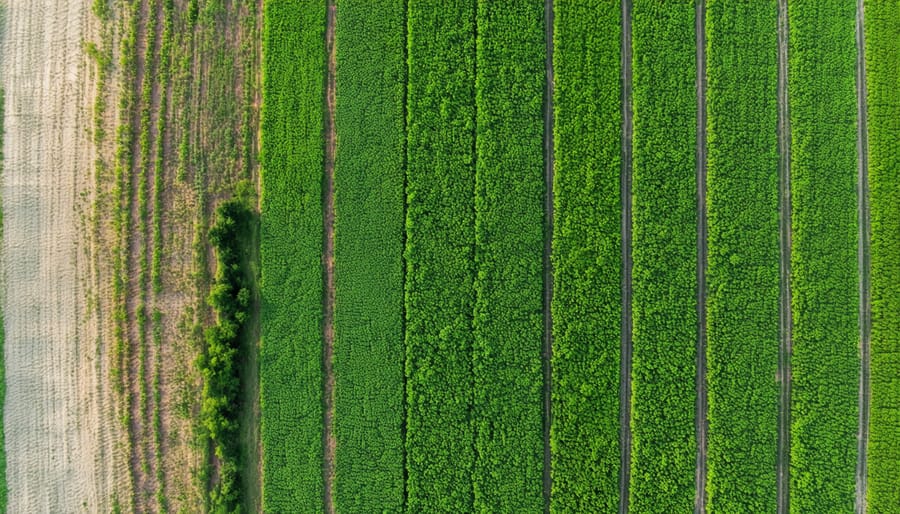
Economic Benefits and Policy Support
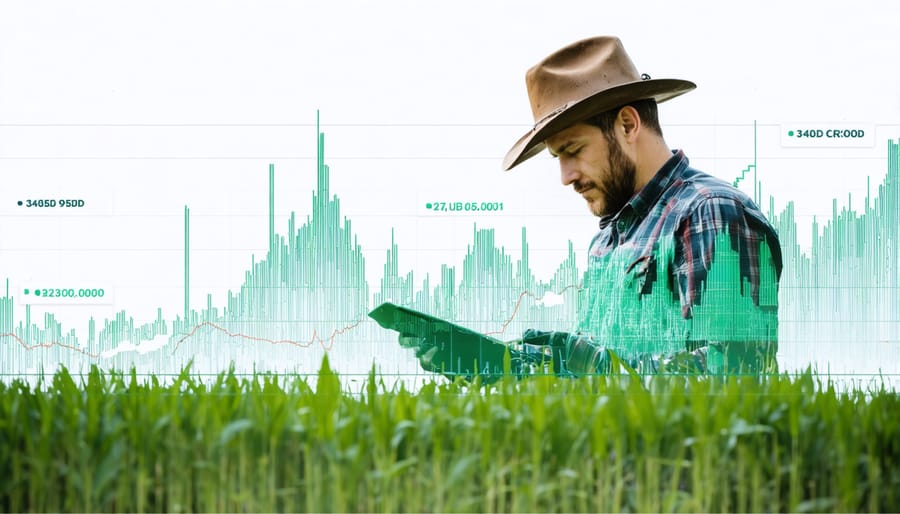
Cost Reduction Strategies
Implementing agroecological practices can significantly reduce operational costs while building sustainable farm livelihoods. Many Alberta farmers report 20-30% reduction in input costs within the first two years of transition.
Key cost-saving strategies include:
Natural Pest Management: By introducing beneficial insects and companion planting, farmers can reduce pesticide expenses by up to 60%. Native flowering plants along field edges attract pollinators while supporting natural pest control.
Soil Health Investment: While initial costs for cover crops may seem high, they typically pay for themselves within 1-2 seasons through reduced fertilizer needs and improved water retention. Local farmers report saving $40-60 per hectare on fertilizer costs.
Water Management: Installing efficient irrigation systems and implementing moisture-conservation practices can reduce water usage by 30-40%. Mulching and reduced tillage help retain soil moisture, cutting irrigation costs significantly.
Seed Saving: Developing a seed-saving program can reduce annual seed costs by 40-50%. Many Alberta farmers participate in seed-sharing networks, further reducing expenses while preserving local varieties.
Energy Efficiency: Simple changes like timing field operations and maintaining equipment can reduce fuel consumption by 15-25%. Some operations have successfully integrated solar pumps for irrigation, cutting energy costs by up to 70% long-term.
Available Funding Programs
Canadian farmers pursuing agroecological practices have access to several key funding programs at both federal and provincial levels. The Canadian Agricultural Partnership (CAP) offers substantial support through its Environmental Sustainability and Climate Change programs, providing up to $50,000 per project for initiatives that enhance soil health and promote biodiversity.
In Alberta, the Environmental Stewardship and Climate Change Producer Program provides cost-shared grants ranging from $5,000 to $100,000 for farmers implementing sustainable agricultural practices. The program specifically supports projects focused on water management, soil conservation, and climate-resilient farming methods.
The Agricultural Clean Technology Program offers funding for innovative sustainable farming equipment and infrastructure, with contributions of up to 50% for for-profit organizations and 75% for not-for-profit entities. Alberta producers can also access the Farm Water Supply Program, which provides up to $5,000 in funding for water management projects supporting sustainable irrigation practices.
Local conservation authorities and agricultural societies frequently offer smaller grants and cost-sharing opportunities for specific agroecological initiatives. The Alberta Environmental Farm Plan Company provides additional resources and potential funding paths for farmers working to enhance their environmental stewardship.
Farmers interested in these programs should connect with their local agricultural fieldman or Alberta Agriculture and Forestry office for application assistance and deadline information. Many programs require a detailed project plan and environmental impact assessment before funding approval.
Real Success Stories: Alberta Farmers Leading the Way
The transformative power of agroecological farming is best illustrated through the success stories of Alberta farmers who have embraced these sustainable practices. Meet Sarah Henderson, a third-generation farmer from Lacombe County, who transitioned her 800-hectare grain operation to an integrated crop-livestock system over the past five years.
“Initially, I was skeptical about changing our traditional methods,” Sarah shares. “But after implementing cover cropping and rotational grazing, we’ve reduced our input costs by 40% while maintaining yields.” Her farm now integrates cattle grazing with diverse crop rotations, including legumes and winter cereals, resulting in improved soil health and reduced dependency on synthetic fertilizers.
In the Peace River region, James and Maria Rodriguez have revolutionized their family farm by adopting agroecological practices. Their 400-hectare operation now features windbreaks, pollinator strips, and integrated pest management systems. “We’ve seen a remarkable increase in beneficial insects,” Maria notes, “and our pest control costs have dropped by 60% since implementing these changes.”
The Wheatland County Collective, a group of six neighboring farms, demonstrates the power of community-based agroecological approaches. Led by veteran farmer Tom Mitchell, these operations share resources, knowledge, and equipment to support their transition to regenerative practices. Their collaborative approach has helped reduce individual investment costs while accelerating learning curves.
Near Lethbridge, Indigenous farmer Robert Standing Bear combines traditional ecological knowledge with modern agroecological principles on his 240-hectare farm. His innovative three-sisters companion planting system, scaled for commercial production, has become a model for cultural preservation and sustainable agriculture.
These success stories share common elements: a gradual transition period, strong community support networks, and careful documentation of results. Each farmer emphasizes the importance of starting small, measuring outcomes, and adapting practices to local conditions.
“The key is patience and observation,” explains Henderson. “We spent the first year just monitoring soil health and studying our land’s natural patterns before making major changes.”
These Alberta pioneers demonstrate that agroecological farming isn’t just environmentally sustainable – it’s economically viable. Their experiences provide practical blueprints for other farmers considering the transition, showing that with proper planning and support, agroecological methods can thrive in Alberta’s diverse agricultural landscape.
Practical Implementation Steps
Assessment and Planning
Successful transition to agroecological farming begins with thorough assessment and strategic planning. Start by conducting a comprehensive farm evaluation using the Canadian Ecological Farm Assessment Tool (CEFAT), which helps identify your operation’s current ecological status and potential areas for improvement.
Document your existing soil conditions through regular testing, mapping water resources, and cataloging biodiversity. This baseline data becomes invaluable when tracking progress and adapting management strategies. Consider implementing circular farming systems that maximize resource efficiency and minimize waste.
Create a detailed transition timeline, typically spanning 3-5 years, breaking down changes into manageable phases. Priority areas often include:
– Soil health improvement strategies
– Water management systems
– Biodiversity enhancement
– Crop rotation planning
– Integration of livestock (if applicable)
Connect with local agricultural extension services and experienced agroecological farmers for guidance. The Alberta Agroecological Network offers peer-to-peer mentorship programs and practical workshops to support your journey. Remember to factor in seasonal variations and climate patterns specific to your region when developing your implementation schedule.
Regular monitoring and documentation of changes help track progress and adjust strategies as needed. Consider using digital tools like farm management apps or simple spreadsheets to maintain organized records of your transition process.
Implementation Timeline
Transitioning to agroecological farming is best approached through a gradual, season-by-season implementation. In Alberta’s climate, begin your transition during early spring (March-April) by soil testing and introducing cover crops that suit local conditions. Start with a small test plot of 1-2 hectares to minimize risk while learning.
During late spring (May-June), focus on establishing diverse crop rotations and integrating natural pest management strategies. This is also the ideal time to plant beneficial insect corridors using native flowering species adapted to the Prairie region.
Summer months (July-August) are perfect for implementing water conservation practices such as mulching and installing drip irrigation systems. Monitor soil health and biodiversity indicators, keeping detailed records of improvements and challenges.
Fall (September-October) is crucial for soil building. Plant winter cover crops, establish windbreaks, and begin composting crop residues. This is also the time to plan next season’s crop rotations and assess your progress.
Winter (November-February) provides opportunity for community knowledge sharing, attending workshops, and planning infrastructure improvements. Use this time to analyze your first-year results and adjust strategies accordingly.
Most farmers successfully transition to full agroecological practices within 3-5 years. Remember that each farm’s timeline will vary based on existing soil conditions, available resources, and local climate patterns. Start small, document your progress, and gradually expand successful practices across your operation.
The journey toward agroecological farming represents a vital step forward for Canadian agriculture, offering a balanced approach that benefits both farmers and the environment. Throughout Alberta, we’re seeing growing evidence that these methods can successfully combine profitability with ecological responsibility. By integrating natural processes, reducing external inputs, and building soil health, farmers are creating more resilient agricultural systems.
For those ready to begin their transition, start with soil testing and establishing baseline measurements of your farm’s current state. Connect with local farming networks and agricultural extension services that can provide guidance and support. Consider implementing changes gradually, perhaps starting with a small plot to test new methods while maintaining conventional practices elsewhere.
Remember that success in agroecological farming comes from understanding your specific context and adapting practices accordingly. Take advantage of available resources through provincial agricultural programs and join farmer-to-farmer learning groups in your region. By sharing experiences and learning from others who have already made the transition, you’ll be better equipped to overcome challenges and achieve your goals.
The future of Canadian agriculture lies in sustainable, resilient farming systems. Your next steps, however small, contribute to this larger vision of agricultural transformation.

